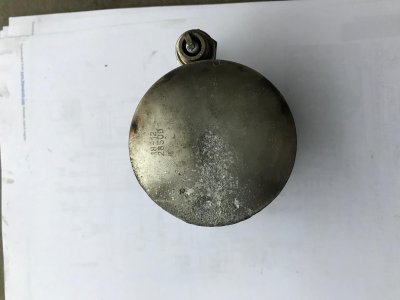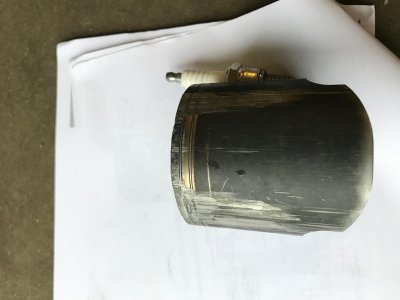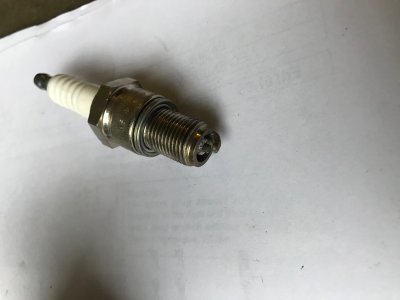You are using an out of date browser. It may not display this or other websites correctly.
You should upgrade or use an alternative browser.
You should upgrade or use an alternative browser.
Coolant exiting from spark plug hole and between cylinder and engine block
- Thread starter Mikeyx
- Start date
So, which parts do I need to get the bike (possibly) running?
- PV triangle (according to an Aussie parts dealer, the tiny stud comes with the triangle)
- according to parts diagram, there are two cyl bottom seals
- according to parts diagram, there are two cyl head seals
Anything else? I was thinking of replacing the piston, but since the bearings are an unknown, I must skip it at this stage.
- PV triangle (according to an Aussie parts dealer, the tiny stud comes with the triangle)
- according to parts diagram, there are two cyl bottom seals
- according to parts diagram, there are two cyl head seals
Anything else? I was thinking of replacing the piston, but since the bearings are an unknown, I must skip it at this stage.
swazi_matt
Active member
there are multiple thicknesses of base gasket, there are those who are a bit smarter and may take the opportunity to try and improve squish or adjust how the bike performs by changing the thickness, however if you just want it running again i would try to get the same thickness gasket that is already in there
On another note, if the PV assembly had coolant in it there will most likely also be coolant leaked from there into the gearbox, so that will also need flushing. Having drowned my bikes in the past i know that trying to flush the gbox with oil will make you broke before it stops turning white and have always used kerosene (drain oil, fill with same volume of kerosene, ride it around for a minute to mix it all up and then drain it and that will be all the water out. I believe ATF also works)
On another note, if the PV assembly had coolant in it there will most likely also be coolant leaked from there into the gearbox, so that will also need flushing. Having drowned my bikes in the past i know that trying to flush the gbox with oil will make you broke before it stops turning white and have always used kerosene (drain oil, fill with same volume of kerosene, ride it around for a minute to mix it all up and then drain it and that will be all the water out. I believe ATF also works)
Jakobi
Super Moderator
I've drowned every one of my gassers... never had water in the transmission. Have had them spurting like a whale from the plug hole though! 

You'd think I'd have learnt by now.
What others have said.
Head o-rings, base gasket, little gasket at the water intake on the head, and probably some o-rings for the pipe spigot while you're at it.
Pay particular attention when you pull it down to where the gasket has failed.
Make sure all surfaces are flat before reassembling. Make sure all moisture has been removed. Use some sealant on the case joints at the front and rear before putting the gasket down. I'd suggest a 0.5mm gasket too. They are the rubber coated steel ones.. much more resilient than the thinner paper ones.
You'd think I'd have learnt by now.
What others have said.
Head o-rings, base gasket, little gasket at the water intake on the head, and probably some o-rings for the pipe spigot while you're at it.
Pay particular attention when you pull it down to where the gasket has failed.
Make sure all surfaces are flat before reassembling. Make sure all moisture has been removed. Use some sealant on the case joints at the front and rear before putting the gasket down. I'd suggest a 0.5mm gasket too. They are the rubber coated steel ones.. much more resilient than the thinner paper ones.
swazi_matt
Active member
never had water in gearbox with the gasser, but had it on a cr250 - didn't even drown it, although i must have been very close to it, must have a different venting systemI've drowned every one of my gassers... never had water in the transmission. Have had them spurting like a whale from the plug hole though!
You'd think I'd have learnt by now.
What others have said.
Head o-rings, base gasket, little gasket at the water intake on the head, and probably some o-rings for the pipe spigot while you're at it.
Pay particular attention when you pull it down to where the gasket has failed.
Make sure all surfaces are flat before reassembling. Make sure all moisture has been removed. Use some sealant on the case joints at the front and rear before putting the gasket down. I'd suggest a 0.5mm gasket too. They are the rubber coated steel ones.. much more resilient than the thinner paper ones.
Reason i say it may have happened here is that his coolant had leaked into the PV assembly and as far as i know the PV rod goes strait through a hole into the gearbox compartment
Jakobi
Super Moderator
never had water in gearbox with the gasser, but had it on a cr250 - didn't even drown it, although i must have been very close to it, must have a different venting system
Reason i say it may have happened here is that his coolant had leaked into the PV assembly and as far as i know the PV rod goes strait through a hole into the gearbox compartment
It certainly does!
She's alive!
Now the bike is back in one piece with a new stator (most likely unnecessarily replaced) and a new piston (gives more grunt).
When the piston was removed, I did not feel any radial play in the bearings. The conrod could be moved +/- 2 mm sideways; dunno if that's allowable or not.
Having emptied the coolant and flushed the crankcase with 2-stroke gas, I filled the crack with gas and let it evaporate over time to leave an oil film on the surfaces. Time will tell if there's any damage...
Thank you for help and information!
Now the bike is back in one piece with a new stator (most likely unnecessarily replaced) and a new piston (gives more grunt).
When the piston was removed, I did not feel any radial play in the bearings. The conrod could be moved +/- 2 mm sideways; dunno if that's allowable or not.
Having emptied the coolant and flushed the crankcase with 2-stroke gas, I filled the crack with gas and let it evaporate over time to leave an oil film on the surfaces. Time will tell if there's any damage...
Thank you for help and information!
Time to wrap this ordeal up...
With a new piston and stator installed, I managed to ride the a few times until it died. No spark.
Had it towed to a nearby dirtbike workshop. They found that I had routed the wiring loom the wrong way and the flywheel had frayed the wiring and caused also melting on the windings.
So I purchased a new stator and had them install it. While riding back home from the workshop, a few km's at steady speed (6th gear, 6000 rpm, 85 km/h), the engine died. While waiting for the tow truck I noticed that there was no compression - so nothing to do with the previous repair at the workshop. At home I opened the engine and found that the plug and piston had melted. My jetting: 38/175/N3CJ. I'd been using the past year Denso W22 plug which is one notch hotter than recommended.
Took the cylinder to the workshop. It could have been repaired by just cleaning the aluminum with acid, but they found a crack between the channels. So I chose to purchase a refurbished cylinder from gasgas-outlet.de (180EUR+50EUR for welding job+ sending the old cylinder).
If the bike were a KTM I would have put it into pieces and sold the parts. Unfortunately GG is a rare make back here, and hence there is no market for GG parts...
With a new piston and stator installed, I managed to ride the a few times until it died. No spark.
Had it towed to a nearby dirtbike workshop. They found that I had routed the wiring loom the wrong way and the flywheel had frayed the wiring and caused also melting on the windings.
So I purchased a new stator and had them install it. While riding back home from the workshop, a few km's at steady speed (6th gear, 6000 rpm, 85 km/h), the engine died. While waiting for the tow truck I noticed that there was no compression - so nothing to do with the previous repair at the workshop. At home I opened the engine and found that the plug and piston had melted. My jetting: 38/175/N3CJ. I'd been using the past year Denso W22 plug which is one notch hotter than recommended.
Took the cylinder to the workshop. It could have been repaired by just cleaning the aluminum with acid, but they found a crack between the channels. So I chose to purchase a refurbished cylinder from gasgas-outlet.de (180EUR+50EUR for welding job+ sending the old cylinder).
If the bike were a KTM I would have put it into pieces and sold the parts. Unfortunately GG is a rare make back here, and hence there is no market for GG parts...
Attachments
(F5)
Gold Level Site Supporter
Gee you've had a bad run.
On mine the stator came with an oval washer to fix the ignition timing in the correct place. Is this fitted? Also what is Octane of gas there? There are 2 main stds. Ron and Mon. Can never remember which is which and have to Google.
I'd say the ignition is too advanced for the petrol being used. Would be interesting to know compression ratio. I closed my squish up but machine a wad out of the head as it was too high once closed gap.
On mine the stator came with an oval washer to fix the ignition timing in the correct place. Is this fitted? Also what is Octane of gas there? There are 2 main stds. Ron and Mon. Can never remember which is which and have to Google.
I'd say the ignition is too advanced for the petrol being used. Would be interesting to know compression ratio. I closed my squish up but machine a wad out of the head as it was too high once closed gap.
You are not gonna believe this... but I'm not making this up.
On her maiden voyage with the new piston & cylinder, I got again a piston failure!
Now riding with a 180 main jet instead of 175; recommended W24 plug instead of W22. Riding at 95 km/h and revving the engine in 2 s intervals instead of a steady throttle. Some 1 km on a highway the engine stalled, the rear wheel locked and gave a good rear slide and almost got rear-ended by a street bike before I found the clutch lever. Scary shit! Engine again with no compression.
Findings:
- spark plug intact and having a healthy dark brown colour (as if mixture was ok)
- top of the piston intact w/o any damage whatsoever (timing is correct?)
- sides of the piston having identical damage as in the pic I posted above
- the oval timing thingy in place in the stator backing plate (timing correct)
- crank shaft can be rotated by the coolant pump impeller (cooling ok)
I mean, does it leave any other option apart from an incorrect oil/gas mixture?
On her maiden voyage with the new piston & cylinder, I got again a piston failure!
Now riding with a 180 main jet instead of 175; recommended W24 plug instead of W22. Riding at 95 km/h and revving the engine in 2 s intervals instead of a steady throttle. Some 1 km on a highway the engine stalled, the rear wheel locked and gave a good rear slide and almost got rear-ended by a street bike before I found the clutch lever. Scary shit! Engine again with no compression.
Findings:
- spark plug intact and having a healthy dark brown colour (as if mixture was ok)
- top of the piston intact w/o any damage whatsoever (timing is correct?)
- sides of the piston having identical damage as in the pic I posted above
- the oval timing thingy in place in the stator backing plate (timing correct)
- crank shaft can be rotated by the coolant pump impeller (cooling ok)
I mean, does it leave any other option apart from an incorrect oil/gas mixture?
Anders
Gold Level Site Supporter
You are not gonna believe this... but I'm not making this up.
On her maiden voyage with the new piston & cylinder, I got again a piston failure!
....
I mean, does it leave any other option apart from an incorrect oil/gas mixture?
What type of oil and what mix rate (in %) do you use?
I've been using fully synthetic 2-stroke oil for bikes @ 2%. Of course, I may have measured the oil incorrectly or not mixed it thoroughly before using.
I just recalled my mechanic telling me that he had noticed a small leak in the flywheel side crank seal. If that were the culprit, then a lean mix would have caused my issues. But the brown color on the plug still shows somewhere else.
The mechanic will show the piston and cyl to a friend of his who is an expert on twostrokers. If he concurs with a lean mix, then I'll first put the engine together with a new piston and try spraying start pilot into the flywheel housing before replacing the crank seal.
I just recalled my mechanic telling me that he had noticed a small leak in the flywheel side crank seal. If that were the culprit, then a lean mix would have caused my issues. But the brown color on the plug still shows somewhere else.
The mechanic will show the piston and cyl to a friend of his who is an expert on twostrokers. If he concurs with a lean mix, then I'll first put the engine together with a new piston and try spraying start pilot into the flywheel housing before replacing the crank seal.
The vendor mentioned that the cylinder is "A" and hence purchased "A" piston (71.94 mm).
Cylinder bore was marked, but I do not recall it. It was some 0.5mm larger than the piston.
But let me remind that similar damage was done to a new A piston installed in the old OEM cylinder.
Cylinder bore was marked, but I do not recall it. It was some 0.5mm larger than the piston.
But let me remind that similar damage was done to a new A piston installed in the old OEM cylinder.
Diesel
Yes, and Diesel has a much higher flashpoint than gasoline, so diesel is safer to work with in this situation.
Diesel is the business, better than gas for absorbing water.
Yes, and Diesel has a much higher flashpoint than gasoline, so diesel is safer to work with in this situation.
Leak Down Test
Just my 2 cents, if you have a flywheel side main seal air leak, you will have a lean condition and seizure. The air leak could vary in volume and you could have a brown plug reading at a certain throttle opening then an immediate lean condition based on leak volume and throttle opening. Your mechanic should have replaced that leaking flywheel side main seal, then performed a new leak down test on the engine.
Just my 2 cents, if you have a flywheel side main seal air leak, you will have a lean condition and seizure. The air leak could vary in volume and you could have a brown plug reading at a certain throttle opening then an immediate lean condition based on leak volume and throttle opening. Your mechanic should have replaced that leaking flywheel side main seal, then performed a new leak down test on the engine.
Jacob 'Berg
Member
Seems like there should have been some detonation/pinging if it was lean enough to seize the piston in the cylinder. If the damage is on the exhaust side of the cylinder and piston only, you were likely running lean.
Any sign of detonation on the piston crown?
Any aluminum on the plug? Look closely with a magnifying glass.
Check the bottom of the piston for a heat pattern.
Was the bike warmed up properly? Sufficient lubrication? If you have a four corner seizure it may be due to cold seizure or insufficient lubrication.
Any sign of detonation on the piston crown?
Any aluminum on the plug? Look closely with a magnifying glass.
Check the bottom of the piston for a heat pattern.
Was the bike warmed up properly? Sufficient lubrication? If you have a four corner seizure it may be due to cold seizure or insufficient lubrication.
Similar threads
- Replies
- 35
- Views
- 24K
- Replies
- 1
- Views
- 4K



